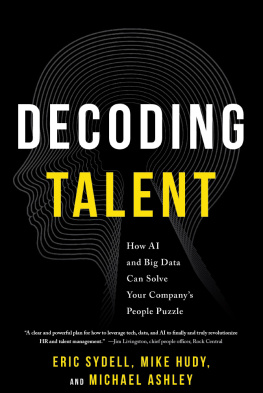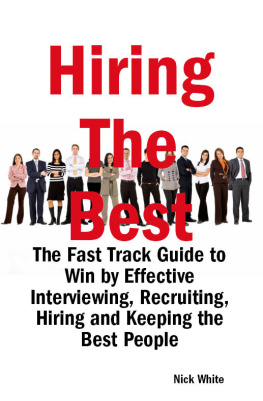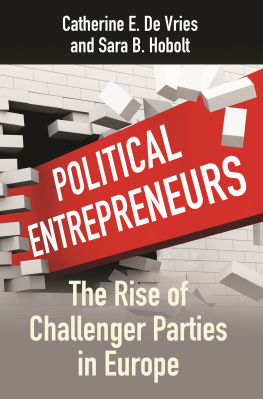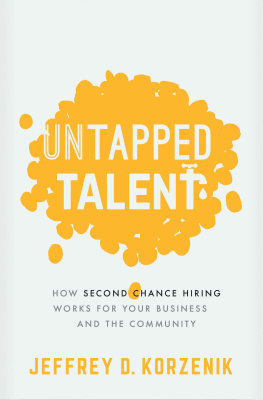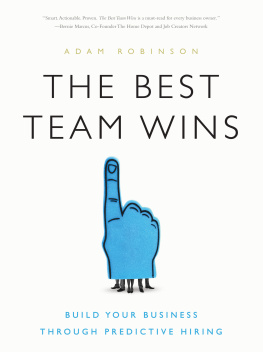
This publication is designed to provide accurate and authoritative information in regard to the subject matter covered. It is sold with the understanding that the publisher and author are not engaged in rendering legal, accounting, or other professional services. Nothing herein shall create an attorney-client relationship, and nothing herein shall constitute legal advice or a solicitation to offer legal advice. If legal advice or other expert assistance is required, the services of a competent professional should be sought.
Fast Company Press
New York, New York
www.fastcompanypress.com
Copyright 2022 Modern Hire
All rights reserved.
Thank you for purchasing an authorized edition of this book and for complying with copyright law. No part of this book may be reproduced, stored in a retrieval system, or transmitted by any means, electronic, mechanical, photocopying, recording, or otherwise, without written permission from the copyright holder.
This work is being published under the Fast Company Press imprint by an exclusive arrangement with Fast Company. Fast Company and the Fast Company logo are registered trademarks of Mansueto Ventures, LLC. The Fast Company Press logo is a wholly owned trademark of Mansueto Ventures, LLC.
Distributed by Greenleaf Book Group
For ordering information or special discounts for bulk purchases, please contact Greenleaf Book Group at PO Box 91869, Austin, TX 78709, 512.891.6100.
Design and composition by Greenleaf Book Group and Sheila Parr Cover design by Greenleaf Book Group and Sheila Parr
Publishers Cataloging-in-Publication data is available.
Print ISBN: 978-1-63908-009-0
eBook ISBN: 978-1-63908-010-6

Part of the Tree Neutral program, which offsets the number of trees consumed in the production and printing of this book by taking proactive steps, such as planting trees in direct proportion to the number of trees used: www.treeneutral.com
Printed in the United States of America on acid-free paper
21 22 23 24 25 26 10 9 8 7 6 5 4 3 2 1
First Edition
To our children,
Ava and Lily
Eric
Makyala and Morgan
Mike
Teddy and Sammy
Michael
CONTENTS
ACKNOWLEDGMENTS
This book has been a team effort from the beginning. At Modern Hire, we thank Jen Wason for her phenomenal editing skills (and patience), Tiana Rownd for keeping the wheels on the bus, and Erin Iafelice for her sage counsel. We also thank Jay Miller for getting the project off the ground and guiding it in the early stages, Peter Baskin and Kim Macdonald for their steerage and advice, and Jennifer Hurd Studebaker for her thorough research support.
Of course, we could not have written Decoding Talent without substantial input from our clients and professional colleagues. We thank all those who sacrificed free time between their pandemic video meetings to chat with us about the future of talent management and hiring.
Finally, we thank our amazing publishing team at Greenleaf Book Group and Fast Company Press, including Jen Glynn, Scott James, Corrin Foster, Rebecca Logan, Judy Marchman, Killian Piraro, Justin Branch, and Sheila Parr. They are true experts in the publishing process and a joy to work with.
INTRODUCTION
Subsumed as they are by the hustle and bustle of our daily lives, all the seismic technological changes afoot can be hard to see. But since the advent of the artificial intelligence (AI) technique called deep learning near the start of this millennium, machines have been developing truly stunning abilities to make sense of our world. Deep learning is essentially a data analysis technique, a paradigm-shifting statistical tool allowing us to process and make sense of all kinds of data faster and more thoroughly. Some of the amazing (and entertaining) things deep learning has produced include:
Cars that can nearly drive themselves
Virtual assistants that understand increasingly more of what we ask them
Software that can read medical scans as well as or more accurately than trained physicians
A stunningly de-aged Robert De Niro in the movie The Irishman
Illicit websites that can instantly write a term paper for you
Multiple vaccines for COVID-19 in less than a year, when the previous world record was four years for the mumps vaccine
But while this technology is amazing and sometimes frightening, tremendous structural barriers come with trying to roll it out quickly and widely. These include the following:
Big data is required but often hard to obtain. Tremendous amounts of data are recorded and stored, but the data is not always high quality.
Laws, regulations, and guidelines are woefully slow to evolve. It takes time for lawmakers to reach consensus on how to handle new technologies, but AI is advancing at a rate far beyond our ability to civilize it.
Access to data is often restricted, intentionally or unintentionally. Many times, organizations house data for safekeeping without any reasonable way to access and analyze it. They store the data, but we cant see the data. Its sort of like keeping your fine jewelry in a safe deposit boxa good way to keep it safe but not very convenient to access.
Concerns related to privacy and bias, while addressable, lead to confusion and loss of momentum. It is a massive under-statement to say that AI is powerful, and with that power comes great potential for benefit and harm.
Do these challenges mean we should oppose AI and work to limit its adoption? We dont think so, because it would cede technological leadership to those who do not have such scruples (and there are many). Instead, we elect to take a strong stance on AI: It should be harnessed for the benefit of humanity. This principle means individuals should benefit, not just corporate entities. If AI is used to continually make organizations more efficient, it will eventually do so at the expense of the people who make up organizations. It will ultimately dehumanize us.
AI does not cause biasit reveals it. Its the humans using AI incorrectly who cause or exacerbate existing biases. In many ways we are entering a golden age of understanding and identifying bias. Big data and powerful algorithms are uncovering it in places we never knew it existed. As difficult as it might be to face, AI being able to locate more bias in all the different places it lurks is a positive developmentbecause it also comes with the knowledge to see bias and address it.
Many AI vendors talk about trusted AI and bias-free AI, but these phrases involve some wishful thinking. Any tool that is in any way opaque in how it operateswhich a lot of AI technology iscan never be fully trusted or left to its own devices. Nor can we ever assume it is bias-free, even if an analysis at one point showed it was. As more data arrives and algorithms evolve, bias will be reintroduced. The solution is to continually monitor the structure and functioning of AI and, when bias is found, to fix it.
Even so, the biggest barrier to the realization of the potential of deep learning is us. We humans struggle to envision and comprehend possible futures, especially ones involving complex advanced technologies. We must see concrete examples and results for those futures to feel real and immediate to us. And we are fearfulfearful of the unknown, fearful of change. Of course, this natural intransigence allows us the time to civilize and tame new technologies, thus limiting the potential for negative and often unforeseen downsides. But it does so only as a
Next page
